先上代码:
from __future__ import absolute_import from __future__ import division from __future__ import print_function # -*- coding: utf-8 -*- """ Created on Tue Nov 14 20:34:00 2017 @author: HJL """ # Copyright 2015 The TensorFlow Authors. All Rights Reserved. # # Licensed under the Apache License, Version 2.0 (the "License"); # you may not use this file except in compliance with the License. # You may obtain a copy of the License at # # http://www.apache.org/licenses/LICENSE-2.0 # # Unless required by applicable law or agreed to in writing, software # distributed under the License is distributed on an "AS IS" BASIS, # WITHOUT WARRANTIES OR CONDITIONS OF ANY KIND, either express or implied. # See the License for the specific language governing permissions and # limitations under the License. # ============================================================================== """A deep MNIST classifier using convolutional layers. See extensive documentation at https://www.tensorflow.org/get_started/mnist/pros """ # Disable linter warnings to maintain consistency with tutorial. # pylint: disable=invalid-name # pylint: disable=g-bad-import-order import argparse import sys #import tempfile import time from tensorflow.examples.tutorials.mnist import input_data import tensorflow as tf FLAGS = None def deepnn(x): """deepnn builds the graph for a deep net for classifying digits. Args: x: an input tensor with the dimensions (N_examples, 784), where 784 is the number of pixels in a standard MNIST image. Returns: A tuple (y, keep_prob). y is a tensor of shape (N_examples, 10), with values equal to the logits of classifying the digit into one of 10 classes (the digits 0-9). keep_prob is a scalar placeholder for the probability of dropout. """ # Reshape to use within a convolutional neural net. # Last dimension is for "features" - there is only one here, since images are # grayscale -- it would be 3 for an RGB image, 4 for RGBA, etc. with tf.name_scope('reshape'): x_image = tf.reshape(x, [-1, 28, 28, 1]) tf.summary.image('input_image', x_image) # First convolutional layer - maps one grayscale image to 32 feature maps. with tf.name_scope('conv1'): W_conv1 = weight_variable([5, 5, 1, 32]) b_conv1 = bias_variable([32]) h_conv1 = tf.nn.relu(conv2d(x_image, W_conv1) + b_conv1) tf.summary.histogram('W_conv1', W_conv1) # Pooling layer - downsamples by 2X. with tf.name_scope('pool1'): h_pool1 = max_pool_2x2(h_conv1) # Second convolutional layer -- maps 32 feature maps to 64. with tf.name_scope('conv2'): W_conv2 = weight_variable([5, 5, 32, 64]) b_conv2 = bias_variable([64]) h_conv2 = tf.nn.relu(conv2d(h_pool1, W_conv2) + b_conv2) # Second pooling layer. with tf.name_scope('pool2'): h_pool2 = max_pool_2x2(h_conv2) # Fully connected layer 1 -- after 2 round of downsampling, our 28x28 image # is down to 7x7x64 feature maps -- maps this to 1024 features. with tf.name_scope('fc1'): W_fc1 = weight_variable([7 * 7 * 64, 1024]) b_fc1 = bias_variable([1024]) h_pool2_flat = tf.reshape(h_pool2, [-1, 7*7*64]) h_fc1 = tf.nn.relu(tf.matmul(h_pool2_flat, W_fc1) + b_fc1) # Dropout - controls the complexity of the model, prevents co-adaptation of # features. with tf.name_scope('dropout'): keep_prob = tf.placeholder(tf.float32) h_fc1_drop = tf.nn.dropout(h_fc1, keep_prob) # Map the 1024 features to 10 classes, one for each digit with tf.name_scope('fc2'): W_fc2 = weight_variable([1024, 10]) b_fc2 = bias_variable([10]) y_conv = tf.matmul(h_fc1_drop, W_fc2) + b_fc2 return y_conv, keep_prob def conv2d(x, W): """conv2d returns a 2d convolution layer with full stride.""" return tf.nn.conv2d(x, W, strides=[1, 1, 1, 1], padding='SAME') def max_pool_2x2(x): """max_pool_2x2 downsamples a feature map by 2X.""" return tf.nn.max_pool(x, ksize=[1, 2, 2, 1], strides=[1, 2, 2, 1], padding='SAME') def weight_variable(shape): """weight_variable generates a weight variable of a given shape.""" initial = tf.truncated_normal(shape, stddev=0.1) return tf.Variable(initial) def bias_variable(shape): """bias_variable generates a bias variable of a given shape.""" initial = tf.constant(0.1, shape=shape) return tf.Variable(initial) def main(_): # Import data mnist = input_data.read_data_sets('./', one_hot=True) # Create the model x = tf.placeholder(tf.float32, [None, 784]) # Define loss and optimizer y_ = tf.placeholder(tf.float32, [None, 10]) # Build the graph for the deep net y_conv, keep_prob = deepnn(x) with tf.name_scope('loss'): cross_entropy = tf.nn.softmax_cross_entropy_with_logits(labels=y_, logits=y_conv) cross_entropy = tf.reduce_mean(cross_entropy) with tf.name_scope('adam_optimizer'): #train_step = tf.train.AdadeltaOptimizer(1e-4).minimize(cross_entropy) train_step = tf.train.AdamOptimizer(1e-4).minimize(cross_entropy) with tf.name_scope('accuracy'): correct_prediction = tf.equal(tf.argmax(y_conv, 1), tf.argmax(y_, 1)) correct_prediction = tf.cast(correct_prediction, tf.float32) accuracy = tf.reduce_mean(correct_prediction) graph_location = "./log/" #tempfile.mkdtemp() print('Saving graph to: %s' % graph_location) train_writer = tf.summary.FileWriter(graph_location) train_writer.add_graph(tf.get_default_graph())#保存默认的图 tf.summary.scalar('cross_entropy', cross_entropy) tf.summary.scalar('accuracy', accuracy) merged = tf.summary.merge_all() with tf.Session() as sess: #模型保存 step1 saver = tf.train.Saver() checkpoint_dir="./" #返回checkpoint文件中checkpoint的状态 ckpt = tf.train.get_checkpoint_state(checkpoint_dir) #print(ckpt) if ckpt and ckpt.model_checkpoint_path:#如果存在以前保存的模型 print('Restore the model from checkpoint %s' % ckpt.model_checkpoint_path) # Restores from checkpoint saver.restore(sess, ckpt.model_checkpoint_path)#加载模型 start_step = int(ckpt.model_checkpoint_path.split('/')[-1].split('-')[-1]) else:#如果不存在之前保存的模型 sess.run(tf.global_variables_initializer())#变量初始化 start_step = 0 print('start training from new state') for i in range(start_step,start_step+20000): batch = mnist.train.next_batch(50) if i % 100 == 0: train_accuracy = accuracy.eval(feed_dict={ x: batch[0], y_: batch[1], keep_prob: 1.0}) print('step %d, training accuracy %g' % (i, train_accuracy)) #step2 每隔一段时间 保存模型 saver.save(sess, './log/my_test_model',global_step=i) summary,_=sess.run([merged, train_step],feed_dict={x: batch[0], y_: batch[1], keep_prob: 0.5}) train_writer.add_summary(summary, i) #time.sleep(0.5) print('test accuracy %g' % accuracy.eval(feed_dict={ x: mnist.test.images, y_: mnist.test.labels, keep_prob: 1.0})) if __name__ == '__main__': #main() parser = argparse.ArgumentParser() parser.add_argument('--data_dir', type=str, default='./data/MNIST/', help='Directory for storing input data') FLAGS, unparsed = parser.parse_known_args() tf.app.run(main=main, argv=[sys.argv[0]] + unparsed)
上述代码输出如下:
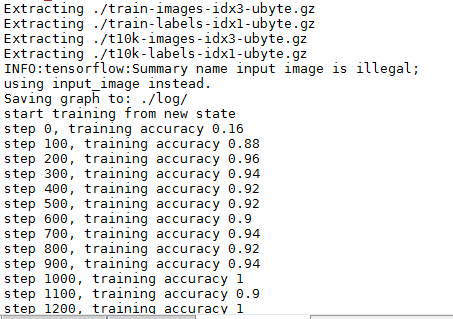
模型的加载与保存
模型的保存涉及到两个函数:
saver = tf.train.Saver()
和
saver.save(sess, './log/my_test_model',global_step=i)
即,先创建tf.train.Saver 对象,用于后续模型保存与加载,默认保存所有参数。saver.save用于将模型及参数保存到文件中,通过传递一个值给可选参数 global_step ,你可以编号checkpoint 名字。上述代码中每隔100步,将模型保存一次。保存结果如下(默认保存最新的5个模型):
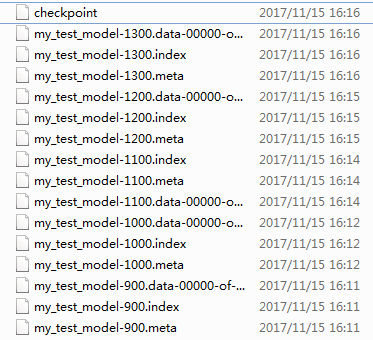
对于模型的加载,涉及如下函数:
saver = tf.train.Saver()
和
saver.restore(sess, ckpt.model_checkpoint_path)
- sess: 用于恢复参数的Session
- save_path: 参数之前保存的路径
TensorBoard简单使用
涉及如下几个函数:
train_writer = tf.summary.FileWriter(graph_location) train_writer.add_graph(tf.get_default_graph()) ... tf.summary.scalar('cross_entropy', cross_entropy)# tf.summary.scalar('accuracy', accuracy) tf.summary.image('input_image', x_image) tf.summary.histogram('W_conv1', W_conv1) merged = tf.summary.merge_all() ... summary,_=sess.run([merged, train_step],feed_dict={x: batch[0], y_: batch[1], keep_prob: 0.5}) train_writer.add_summary(summary, i)
-
Summary:所有需要在TensorBoard上展示的统计结果。 -
tf.name_scope():为Graph中的Tensor添加层级,TensorBoard会按照代码指定的层级进行展示,初始状态下只绘制最高层级的效果,点击后可展开层级看到下一层的细节。 -
tf.summary.scalar():添加标量统计结果。 -
tf.summary.histogram():添加任意shape的Tensor,统计这个Tensor的取值分布。 -
tf.summary.merge_all():添加一个操作,代表执行所有summary操作,这样可以避免人工执行每一个summary op。 -
tf.summary.FileWrite:用于将Summary写入磁盘,需要制定存储路径logdir,如果传递了Graph对象,则在Graph Visualization会显示Tensor Shape Information。执行summary op后,将返回结果传递给add_summary()方法即可。
最后结果:
Scalar
(对应:
tf.summary.scalar('cross_entropy', cross_entropy) tf.summary.scalar('accuracy', accuracy)
)
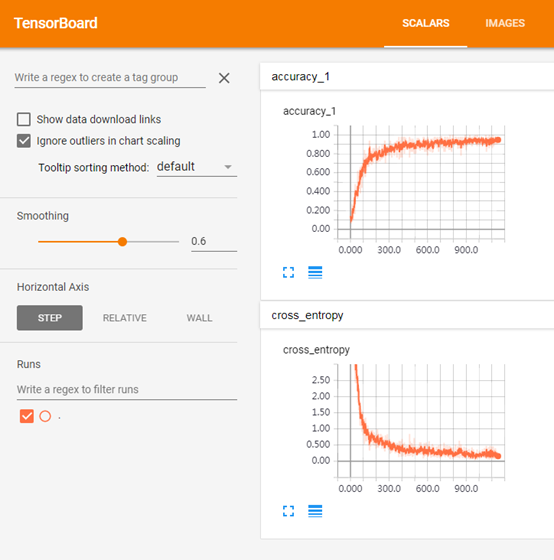
对应:
tf.summary.image('input_image', x_image)
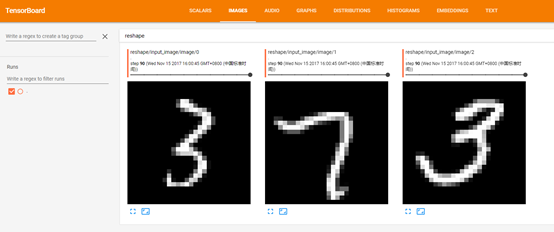
对应:
train_writer.add_graph(tf.get_default_graph())
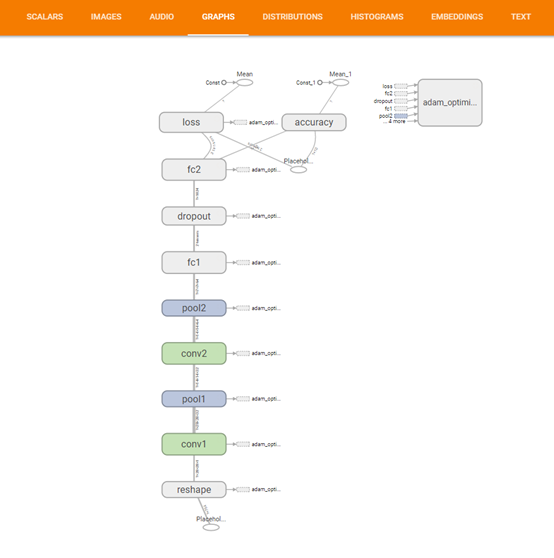
对应:
tf.summary.histogram('W_conv1', W_conv1)



